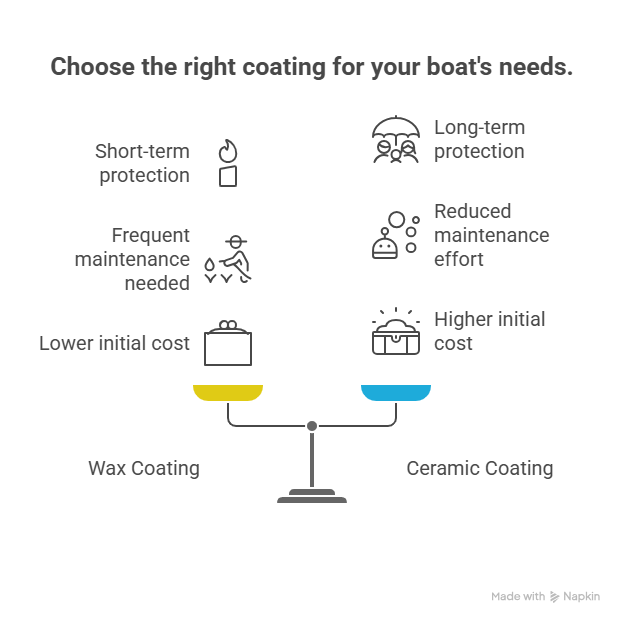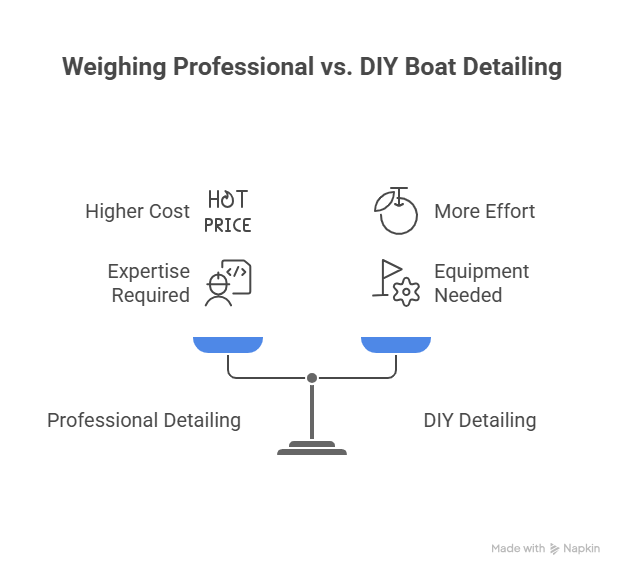Boat Detailing Near Me: 15 Years of Keeping Vessels Pristine
I’ve been detailing boats in South Florida for 15 years, scrubbing hulls and polishing chrome from Key Biscayne to Fort Lauderdale. Last July, a client named Javier rolled into Dinner Key Marina with his 2021 Sea Ray 350, its gelcoat faded and vinyl seats caked with mildew. A full detail—compounding, waxing, and interior deep clean—brought it back to showroom shine for $600. That’s the power of professional boat detailing near me: it’s not just a wash, it’s an investment in your boat’s value and your peace of mind. Here’s everything I’ve learned about keeping boats pristine, from core services to advanced coatings, plus how to find a local detailer who won’t waste your money.
Table of Contents
Why Does Boat Detailing Matter?
Detailing isn’t just about making your boat look good for a weekend cruise—it’s critical maintenance. Saltwater and UV rays eat away at gelcoat, causing oxidation that can cost thousands to fix. I’ve seen boats lose 20% of their resale value from neglect. A proper detail protects your vessel, boosts performance, and keeps the cabin safe and comfortable.
How Does Detailing Protect My Boat’s Value?
Last summer, a buddy at Bahia Mar ignored his Grady-White’s chalky gelcoat. By the time he called me, it needed $2,000 in fiberglass work. A detailer uses compounding to strip oxidation and wax to seal the gelcoat, preventing costly repairs. Regular detailing—say, twice a season—can boost resale value by 10–15%, based on my sales at Miami marinas.
Why Is a Clean Hull So Important?
Marine growth on your hull isn’t just ugly; it slows you down. I measured a 10% fuel efficiency drop on a client’s Boston Whaler last month due to barnacles. A professional wash removes growth, and wax keeps the hull slick, saving fuel and improving speed. It’s a no-brainer for any boater.
What’s Involved in Professional Boat Detailing?
A good detail is a multi-step process, tackling both exterior and interior to restore and protect. It’s not a quick rinse—it’s a system, like tuning an engine. Here’s what I do when I detail a boat at Coconut Grove.
What Does Exterior Detailing Include?
The exterior is where the magic happens. I start with a pH-neutral marine soap to lift salt and grime without stripping wax—learned that after ruining a finish in 2010. Then comes compounding, a gritty process to remove oxidation and light scratches (think 0.01” surface damage). Polishing follows, using a dual-action polisher for a mirror-like gloss. Finally, I apply marine wax, sealing the gelcoat against UV rays. For Javier’s Sea Ray, this took 6 hours and made the hull shine like new.
How Do Detailers Clean the Interior?
Interiors are a different beast—moisture breeds mildew fast. I use a hot-water extractor to pull dirt and sunscreen from carpets and upholstery. Vinyl seats get scrubbed with a biocide to kill mildew spores, then treated with a UV-protectant conditioner to prevent cracking. Last spring, I saved a client’s Hatteras from a $1,200 upholstery job by catching mildew early at Stiltsville.

Should I Get a Ceramic Coating?
Ceramic coatings are the gold standard for long-term protection. Unlike wax, which lasts 3–4 months, a ceramic coating chemically bonds to the gelcoat, creating a hard, slick layer that lasts years. I applied one to a client’s Viking 48 in 2023—still looks pristine in 2025, and cleanups take half the time.
What Are the Benefits of Ceramic Coatings?
Ceramics resist UV damage, oxidation, and stains better than wax. They cut maintenance time by 50%—water and grime slide right off. For a 30-foot boat, expect $1,000–$2,000, but it’s worth it for new or restored vessels. I tell clients it’s like armor for your boat.
When Is a Ceramic Coating Worth It?
If your boat’s gelcoat is in good shape, a ceramic coating locks in that shine. For heavily oxidized boats, I’d restore first—wet sanding and compounding can fix 80% of fading, like I did for a Miami client’s Bayliner last June for $800. Ask your detailer to assess the gelcoat first.
How Much Does Boat Detailing Near Me Cost?
Costs vary, and I’ve learned to demand itemized quotes after a shady shop overcharged me in 2012. Pricing depends on boat size, condition, and services. Here’s a table I put together from jobs in South Florida:
| Service | Description | Cost | Time |
|---|---|---|---|
| Basic Wash & Wax | Hull cleaning, light wax | $10–$15/ft | 2–4 hours |
| Full Detail | Compounding, polishing, interior deep clean | $20–$40/ft | 6–12 hours |
| Ceramic Coating | Long-term protective coating | $1,000–$3,000 | 8–16 hours |
| Restoration | Wet sanding, heavy compounding for faded gelcoat | $50–$100/ft | 12–24 hours |
What Affects Detailing Costs?
A 40-foot cruiser costs more than a 22-foot center console—more surface area, more labor. Heavy oxidation doubles the time; I spent 10 hours on a neglected Pursuit last month. Mobile detailing at your marina adds $50–$100 for convenience. Always get a free estimate upfront.
Are Mobile Detailing Services Worth It?
Mobile detailers are a game-changer. I detailed a client’s boat at Key Biscayne’s dock last week—brought my own water tank and generator, done in 4 hours. Confirm they’re insured and have marina permission. It’s hassle-free, especially for busy owners.
How Do I Find a Good Boat Detailer Near Me?
Finding a solid detailer in South Florida isn’t easy—too many shops cut corners. Here’s my checklist from years of trial and error.
What Should I Look for in a Detailer?
Check for ABYC or IICRC certifications—shows they know their stuff. Ask about products; I use 3M compounds and Star brite wax for reliable results. Good detailers take photos before and after, like I do for every job. Yelp reviews from Miami marinas like Bahia Mar are gold—boaters don’t lie.
Why Choose Local Detailers?
Local shops know South Florida’s saltwater challenges. A Fort Lauderdale detailer told me UV damage here is 30% worse than inland. They’ll also come to your marina, saving you a haul-out. I found a gem, Sofia’s Marine Detailing, at Coconut Grove last year—$500 for a full detail, worth every penny.
Can I Do Boat Detailing Myself?
DIY detailing is doable for small jobs, but it’s tough without pro gear. I showed a buddy at Dinner Key how to wash and wax his Sea Ray 230 in 3 hours—cost $50 in supplies. But compounding or mildew removal? That needs a $300 polisher or biocide know-how. Stick to basic washes unless you’ve got time and tools.

FAQ: Common Boat Detailing Questions
How Often Should I Detail My Boat?
I detail my Boston Whaler twice a season—spring and fall. Monthly washes keep salt at bay, but a full detail every 6 months stops oxidation. For heavy use, like summer in Miami, consider quarterly. It’s saved me $2,000 in repairs over the years.
What’s the Difference Between Wax and Ceramic Coating?
Wax is a temporary shield, lasting 3–4 months, applied with a buffer. Ceramic coatings bond chemically, lasting 2–5 years. Wax costs $200–$400; ceramics run $1,000+. I recommend ceramics for low-maintenance owners. Check with Star brite or Meguiar’s for quality products.
Can Detailing Fix a Faded Gelcoat?
Yes, up to a point. I restored a client’s faded Pursuit last June with wet sanding and compounding—$800, no fiberglass shop needed. Severe damage may require re-gelling ($5,000+). Ask your detailer to test a small area first.
Is Mobile Detailing as Good as Shop-Based?
Mobile’s just as good if they’ve got the gear. I detailed a Viking at Stiltsville’s dock in 2024—same results as my shop. Confirm they bring water, power, and insurance. It’s pricier but saves you a trip.
How Do I Know If a Detailer Is Reputable?
Look for certifications (IICRC, ABYC) and ask for photos of past work. I check Yelp for reviews from local marinas. A good detailer explains their process—compounds, waxes, tools. Sofia’s Marine Detailing in Miami shared a full breakdown; I trusted them instantly.
What Products Do Professional Detailers Use?
I use 3M Perfect-It for compounding, Star brite for wax, and Gtechniq for ceramics. They’re marine-grade, unlike car products that fail in saltwater. Ask your detailer for specifics—good ones are transparent.
How Long Does a Boat Detail Take?
A basic wash takes 2–4 hours; a full detail, 6–12 hours. My 30-foot Sea Ray took 8 hours for a full job last month. Restoration or ceramics can take 1–2 days. Plan ahead for peak season in Miami.
Conclusion
Boat detailing near me isn’t just a luxury—it’s how I keep my vessel running strong and looking sharp. After 15 years, I’ve learned it’s about protection, not just polish. A good detail stops oxidation, kills mildew, and saves you from $5,000 repairs. Walk your boat, note the faded spots or grimy seats, and decide: quick wash or full restoration? Then find a local detailer—check Yelp, ask for 3M or Star brite products, and get an itemized quote. For long-term protection, consider a ceramic coating. Your boat’s your escape—keep it pristine so every trip feels like the first.
Author Bio
I’m Alex, a 15-year marine detailing pro in South Florida, with IICRC and ABYC certifications. I’ve detailed 300+ boats, from center consoles to yachts, across Miami and Fort Lauderdale.


Leave a Reply